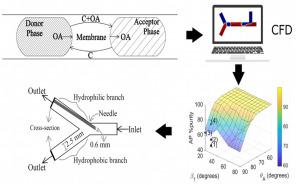Chemical Engineering and Processing: Process Intensification ( IF 4.3 ) Pub Date : 2021-06-24 , DOI: 10.1016/j.cep.2021.108488 Carlos E. Llano-Serna , Ana C. Fernandes , Ulrich Krühne , Javier Fontalvo , Oscar A. Prado-Rubio

|
Bioprocesses development is a fundamental research area nowadays, and downstream processing is one of the main bottlenecks due to its high contribution to production cost. In that regard, process intensification of separation technology is still needed. Particularly, a novel liquid membrane in Taylor flow (LMTF) has demonstrated to intensify organic acid separation performance and potentially facilitate economic bioprocesses viability (Fontalvo and Pérez-Ávila, 2019). However, the current challenge is designing a separation mechanism for the immiscible phases once the extraction has been performed. In this work, a computational fluid dynamic (CFD) approach is used for fast prototype design followed by prototype construction and experimental evaluation. The device aims an immiscible droplets separation based on wettability in a LMTF used for the extraction of lactic acid. Simulation results indicate that a low contact angle for the hydrophilic ramification and a low division angle allowed the best separation performance, where complete phases separation was possible but experimentally some challenges limit the separation performance. CFD simulations have shown to be a powerful tool to assess geometric degrees of freedom which accelerate prototyping and reduce the initial experiments required. The combined LMTF system and drop separation device offers a continuous downstream alternative for bioprocesses further intensification.
中文翻译:

计算流体动力学 (CFD) 辅助设计和原型设计,用于强化渗透系统的不混溶液滴分离部分
生物工艺开发是当今的一个基础研究领域,下游加工因其对生产成本的高贡献而成为主要瓶颈之一。在这方面,仍然需要分离技术的工艺强化。特别是,泰勒流 (LMTF) 中的新型液膜已证明可以增强有机酸分离性能并有可能促进经济生物过程的可行性(Fontalvo 和 Pérez-Ávila,2019 年)。然而,当前的挑战是在萃取完成后为不混溶相设计分离机制。在这项工作中,计算流体动力学 (CFD) 方法用于快速原型设计,然后是原型构建和实验评估。该装置旨在基于用于提取乳酸的 LMTF 中的润湿性进行不混溶的液滴分离。模拟结果表明,亲水分枝的低接触角和低分割角可实现最佳分离性能,其中完全相分离是可能的,但实验上一些挑战限制了分离性能。CFD 模拟已被证明是评估几何自由度的强大工具,可加速原型制作并减少所需的初始实验。LMTF 系统和液滴分离装置的组合为生物过程的进一步强化提供了一个连续的下游替代方案。模拟结果表明,亲水分枝的低接触角和低分割角可实现最佳分离性能,其中完全相分离是可能的,但实验上一些挑战限制了分离性能。CFD 模拟已被证明是评估几何自由度的强大工具,可加速原型制作并减少所需的初始实验。LMTF 系统和液滴分离装置的组合为生物过程的进一步强化提供了一个连续的下游替代方案。模拟结果表明,亲水分枝的低接触角和低分割角可实现最佳分离性能,其中完全相分离是可能的,但实验上一些挑战限制了分离性能。CFD 模拟已被证明是评估几何自由度的强大工具,可加速原型制作并减少所需的初始实验。LMTF 系统和液滴分离装置的组合为生物过程的进一步强化提供了一个连续的下游替代方案。



























 京公网安备 11010802027423号
京公网安备 11010802027423号